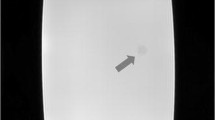Abstract
Objectives
Vendors of medical displays promise a better diagnostic performance using 10- or 11-bit instead of 8-bit monochrome displays. We measured the gain of “Just Noticeable Difference” (JND) steps using high grayscale resolutions and evaluated the preference of radiologists regarding different aspects of image quality.
Methods
The amount of JND steps was measured on a display using 8-, 10- and 11-bit Look Up Tables (LUT). Radiological images were presented simultaneously using an 8-bit and an 11-bit LUT, radiologists where asked to determine the better image presentation regarding quality parameters like sharpness, contrast and detectability of details.
Results
The 10-bit technology realized more than twice the number of JND steps compared to an 8-bit LUT, an 11-bit LUT presented only few additional JND steps. The radiologists did not attest the higher grayscale resolution a better image quality, they regarded the 8-bit technology to show a better sharpness and contrast, although this had no impact on the detectability of details.
Conclusions
Our measurements confirmed that the higher grayscale resolution results in a more complete visualization of image information. But radiologists partially judged this as a lack of sharpness and contrast and generally preferred the 8-bit display.







Similar content being viewed by others
References
Barten PGJ (1992) Physical model for contrast sensitivity of the human eye. Proc SPIE 1666:52–72
Barten PGJ (1999) Contrast sensitivity of the human eye and its effects on image quality. SPIE, Bellingham
National Electrical Manufacturer’s Association (2001) Digital imaging and communications in medicine, Part 14: Grayscale Standard Display Function
Fetterly KA, Blume HR, Flynn MJ, Samei E (2008) Introduction to grayscale calibration and related aspects of medical imaging grade liquid crystal displays. J Digit Imaging 21:193–207. doi:10.1007/s10278-007-9022-y
Sehnert WJ, Keelan BW, Toepfer K (2005) Effect of grayscale resolution on the performance of lung nodule detection on a softcopy display. Proc SPIE Med Imaging 5744:577–585
Siddiqui K, Siegel E, Reiner B, Musk A, Hooper F (2004) 11 Bit versus 8 Bit Monochrome LCD for Interpretation of 12 Bit DICOM Images. Proceedings of the 90th Annual Meeting of the Radiological Society of North America
Krupinski EA, Siddiqui K, Siegel E et al (2007) Influence of 8-bit vs. 11-bit digital displays on observer performance and visual search: a multi-center evaluation. J Soc Inf Disp 15:385–390
Normenausschuss Radiologie: PAS 1054 (Anforderungen und Prüfverfahren für digitale Mammographie-Einrichtungen), http://www.nar.din.de and http://www.pas1054.de. Accessed November 15, 2010
Totoku Electric Co: Required Grayscale Accuracy in Medical Displays, http://www.totoku.com/display/support/pdf/Required_Grayscale_Accuracy_in_Medical_Displays(En)_V10.pdf. Accessed November 15, 2010
American Association of Physicists in Medicine (AAPM), Task Group 18: Assessment of Display Performance for Medical Imaging Systems, http://deckard.mc.duke.edu/~samei/tg18_files/tg18.pdf. Accessed November 15, 2010
Kimpe T, Tuytschaever T (2007) Increasing the number of gray shades in medical display systems—how much is enough? J Digit Imaging 20(4):422–432. doi:10.1007/s10278-006-1052-3
Siddiqui K, Siegel E, Reiner B, Musk A, Crave O (2004) Quantitative differences between 8 Bit and 11 Bit monochrome DICOM images: A visual discrimination model analysis. Proceedings of the 90th Annual Meeting of the Radiological Society of North America
Author information
Authors and Affiliations
Corresponding author
Rights and permissions
About this article
Cite this article
Bender, S., Lederle, K., Weiß, C. et al. 8-bit or 11-bit monochrome displays—which image is preferred by the radiologist?. Eur Radiol 21, 1088–1096 (2011). https://doi.org/10.1007/s00330-010-2014-1
Received:
Revised:
Accepted:
Published:
Issue Date:
DOI: https://doi.org/10.1007/s00330-010-2014-1




